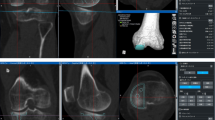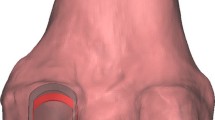Abstract
Purpose
The influence of patient-specific instrumentations on the accuracy of unicompartmental medial knee replacement remains unclear. The goal of this study was to examine the ability of patient-specific instrumentation to accurately reproduce postoperatively what the surgeon had planned preoperatively.
Methods
Twenty consecutive patients (20 knees) who suffered from isolated unicompartmental medial osteoarthritis of the knee and underwent medial knee replacement using newly introduced magnetic resonance imaging-based patient-specific instrumentation were assessed. This assessment recorded the following parameters: (1) the planned and the postoperative mechanical axis acquired through long-leg AP view radiographies; (2) the planned and the postoperative tibial slope acquired by means of standard AP and lateral view radiographies; and (3) the postoperative fit of the implanted components to the bone in coronal and sagittal planes. The hypothesis of the study was that there was no statistically significant difference between postoperative results and preoperatively planned values.
Results
The study showed that (1) the difference between the postoperative mechanical axis (mean 1.9° varus ± 1.2° SD) and the planned mechanical axis (mean 1.8° varus ± 1.2° SD) was not statistically significant; (2) the difference between the postoperative tibial slope (mean 5.2° ± 0.6° SD) and the planned tibial slope (mean 5.4° ± 0.6° SD) was statistically significant (p = 0.008); and (3) the postoperative component fit to bone in the coronal and sagittal planes was accurate in all cases; nevertheless, in one knee, all components were implanted one size smaller than preoperatively planned. Moreover, in two additional cases, one size thinner and one size thicker of the polyethylene insert were used.
Conclusions
This study suggests that overall patient-specific instrumentation was highly accurate in reproducing postoperatively what the surgeon had planned preoperatively in terms of mechanical axis, tibial slope and component fit to bone.
Level of evidence
IV.





Similar content being viewed by others
References
Ackroyd CE (2003) Medial compartment arthroplasty of the knee. J Bone Joint Surg (Br) 85:937–942
Bali K, Walker P, Bruce W (2012) Custom-fit total knee arthroplasty: our initial experience in 32 knees. J Arthroplasty 27:1149–1154
Borus T, Thornhill T (2008) Unicompartmental knee arthroplasty. J Am Acad Orthop Surg 16:9–18
Cobb J, Henckel J, Gomes P, Harris S, Jakopec M, Rodriguez F, Barrett A, Davies B (2006) Hands-on robotic unicompartmental knee replacement: a prospective, randomised controlled study of the Acrobat system. J Bone Joint Surg (Br) 88:188–197
Fitz W (2009) Unicompartmental knee arthroplasty with use of novel patient-specific resurfacing implants and personalized jigs. J Bone Joint Surg (Am) 91:69–76
Geller JA, Yoon RS, Macaulay W (2008) Unicompartmental knee arthroplasty: a controversial history and a rationale for contemporary resurgence. J Knee Surg 21:7–14
Hernigou P, Deschamps G (2004) Posterior slope of the tibial implant and the outcome of unicompartmental knee arthroplasty. J Bone Joint Surg (Am) 86-A:506–511
Hopper GP, Leach WJ (2008) Participation in sporting activities following knee replacement: total versus unicompartmental. Knee Surg Sports Traumatol Arthrosc 16:973–979
Jenny JY, Boeri C (2002) Accuracy of implantation of a unicompartmental total knee arthroplasty with 2 different instrumentations: a case-controlled comparative study. J Arthroplast 17:1016–1020
Kennedy WR, White RP (1987) Unicompartmental arthroplasty of the knee. Postoperative alignment and its influence on overall results. Clin Orthop Relat Res 221:278–285
Koeck FX, Beckmann J, Luring C, Rath B, Grifka J, Basad E (2011) Evaluation of implant position and knee alignment after patient-specific unicompartmental knee arthroplasty. Knee 18:294–299
Laurencin CT, Zelicof SB, Scott RD, Ewald FC (1991) Unicompartmental versus total knee arthroplasty in the same patient. A comparative study. Clin Orthop Relat Res 273:151–156
McCoy BW, Yaffe MA, Stulberg SD (2012) Determining the accuracy of patient-matched instrumentation in total knee arthroplasty. J Bone Joint Surg (Br) 94-B:40
Ng VY, DeClaire JH, Berend KR, Gulick BC, Lombardi AV Jr (2012) Improved accuracy of alignment with patient-specific positioning guides compared with manual instrumentation in TKA. Clin Orthop Relat Res 470:99–107
Riddle DL, Jiranek WA, McGlynn FJ (2008) Yearly incidence of unicompartmental knee arthroplasty in the United States. J Arthroplast 23:408–412
Rosenberger RE, Fink C, Quirbach S, Attal R, Tecklenburg K, Hoser C (2008) The immediate effect of navigation on implant accuracy in primary mini-invasive unicompartmental knee arthroplasty. Knee Surg Sports Traumatol Arthrosc 16:1133–1140
Sinha RK (2009) Outcomes of robotic arm-assisted unicompartmental knee arthroplasty. Am J Orthop 38:20–22
W-Dahl A, Robertsson O, Lidgren L (2010) Surgery for knee osteoarthritis in younger patients. Acta Orthop 81:161–164
Walton NP, Jahromi I, Lewis PL, Dobson PJ, Angel KR, Campbell DG (2006) Patient-perceived outcomes and return to sport and work: TKA versus mini-incision unicompartmental knee arthroplasty. J Knee Surg 19:112–116
Whiteside LA, McCarthy DS (1992) Laboratory evaluation of alignment and kinematics in a unicompartmental knee arthroplasty inserted with intramedullary instrumentation. Clin Orthop Relat Res 274:238–247
Conflict of interest
None of the authors have no conflict of interest.
Author information
Authors and Affiliations
Corresponding author
Rights and permissions
About this article
Cite this article
Volpi, P., Prospero, E., Bait, C. et al. High accuracy in knee alignment and implant placement in unicompartmental medial knee replacement when using patient-specific instrumentation. Knee Surg Sports Traumatol Arthrosc 23, 1292–1298 (2015). https://doi.org/10.1007/s00167-013-2794-3
Received:
Accepted:
Published:
Issue Date:
DOI: https://doi.org/10.1007/s00167-013-2794-3




